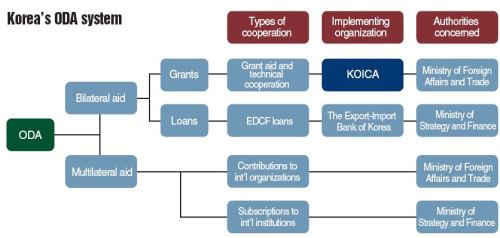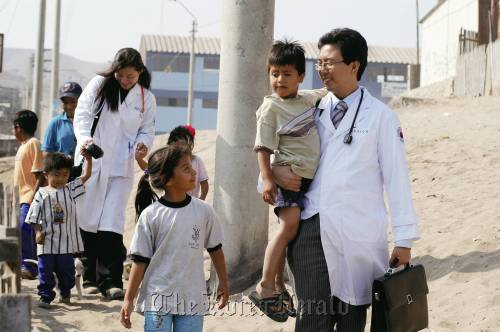OECD’s development assistance committee to review Korea’s aid programs in December
This is the first installment of a series of articles introducing programs and activities of the Korea International Cooperation Agency, a state-run organization for overseas assistance and humanitarian aid. -- Ed.
The Korean government’s aid program, the Korea International Cooperation Agency, has seen rapid growth over the past 20 years since its foundation in 1991, as Korea pulled off “the miracle of the Han River” from the ashes of the 1950-53 Korean War.

The annual budget of the KOICA surged almost 30 times from 17.4 billion won in 1991 to 499 billion won in 2012, reflecting its growing position as the nation’s primary grant ODA (Official Development Aid) agency. Over the last two decades, KOICA’s budget accounted for 47 percent of Korea’s bilateral ODA budget and 78.4 percent of grant aid, according to data from the agency.
With the government’s plan to boost ODA further to reduce poverty and propel sustainable growth in the world, the KOICA will shift its focus this year from the quantity of the aid to result-oriented quality aid, officials at the agency said.
Providing result-oriented aid
One of KOICA’s most significant goals in 2012 will be enhancing aid expertise to provide quality aid so that the recipient countries can benefit from practical results and achievements, said Park Dae-won, president of KOICA.
“We launched the field-based, local-based and result-oriented project implementation system in 2011. This year, we will strengthen the root of the system to boost our competitiveness as an advanced aid institution,” Park told the KOICA staff during his New Year speech.
“We will expand overseas offices and let them exercise more authority in their specialized fields,” he said.
According to Park, KOICA will start an advisory services system in which experts are dispatched overseas for research and cooperation with local governments. KOICA will also start the World Friends Korea program, in which overseas volunteer activities operated by individual Korean ministries are integrated to improve communication with the related ministries and the efficiency of volunteer education, he said.
KOICA officials said the agency is changing its project selection system into a sector-based one.
KOICA designs aid programs, considering cross cutting issues such as gender mainstreaming and environment, as well as areas in which Korea has a comparative advantage.
Under the “2010-2015 KOICA Advancement Plan,” the agency reduced the number of priority sectors from seven to five and chose 25 specific programs for each sector.
KOICA is also seeking more prudence in project selection and implementation, by moving away from one-off and unilateral projects to capacity-building projects.

In addition, it will share lessons learned from executing projects with other ODA organizations in Korea, the agency’s officials noted.
Another important goal for KOICA this year is to build partnerships both at home and abroad, with the Korean government allocating a larger budget to aid.
“Facilitating partnerships is essential in implementing grant aid programs. In particular, we will have deeper consultations with developing countries on the expansion of South-South and triangular cooperation, which were discussed at the Busan High Level Forum on Aid Effectiveness,” said Cho Han-deok, director of planning and budget office at KOICA.
South-South cooperation is that between developing countries. Triangular cooperation involves two countries forming a partnership to lend assistance to a third country.
The OECD’s Development Assistance Committee will conduct a peer review of Korea in December this year, which will be the first since the nation joined the committee’s membership in 2009 in the middle of the world’s economic crisis. It will review the progress of Korea’s development policies and implementations.
This is the first installment of a series of articles introducing programs and activities of the Korea International Cooperation Agency, a state-run organization for overseas assistance and humanitarian aid. -- Ed.
The Korean government’s aid program, the Korea International Cooperation Agency, has seen rapid growth over the past 20 years since its foundation in 1991, as Korea pulled off “the miracle of the Han River” from the ashes of the 1950-53 Korean War.

The annual budget of the KOICA surged almost 30 times from 17.4 billion won in 1991 to 499 billion won in 2012, reflecting its growing position as the nation’s primary grant ODA (Official Development Aid) agency. Over the last two decades, KOICA’s budget accounted for 47 percent of Korea’s bilateral ODA budget and 78.4 percent of grant aid, according to data from the agency.
With the government’s plan to boost ODA further to reduce poverty and propel sustainable growth in the world, the KOICA will shift its focus this year from the quantity of the aid to result-oriented quality aid, officials at the agency said.
Providing result-oriented aid
One of KOICA’s most significant goals in 2012 will be enhancing aid expertise to provide quality aid so that the recipient countries can benefit from practical results and achievements, said Park Dae-won, president of KOICA.
“We launched the field-based, local-based and result-oriented project implementation system in 2011. This year, we will strengthen the root of the system to boost our competitiveness as an advanced aid institution,” Park told the KOICA staff during his New Year speech.
“We will expand overseas offices and let them exercise more authority in their specialized fields,” he said.
According to Park, KOICA will start an advisory services system in which experts are dispatched overseas for research and cooperation with local governments. KOICA will also start the World Friends Korea program, in which overseas volunteer activities operated by individual Korean ministries are integrated to improve communication with the related ministries and the efficiency of volunteer education, he said.
KOICA officials said the agency is changing its project selection system into a sector-based one.
KOICA designs aid programs, considering cross cutting issues such as gender mainstreaming and environment, as well as areas in which Korea has a comparative advantage.
Under the “2010-2015 KOICA Advancement Plan,” the agency reduced the number of priority sectors from seven to five and chose 25 specific programs for each sector.
KOICA is also seeking more prudence in project selection and implementation, by moving away from one-off and unilateral projects to capacity-building projects.

In addition, it will share lessons learned from executing projects with other ODA organizations in Korea, the agency’s officials noted.
Another important goal for KOICA this year is to build partnerships both at home and abroad, with the Korean government allocating a larger budget to aid.
“Facilitating partnerships is essential in implementing grant aid programs. In particular, we will have deeper consultations with developing countries on the expansion of South-South and triangular cooperation, which were discussed at the Busan High Level Forum on Aid Effectiveness,” said Cho Han-deok, director of planning and budget office at KOICA.
South-South cooperation is that between developing countries. Triangular cooperation involves two countries forming a partnership to lend assistance to a third country.
The OECD’s Development Assistance Committee will conduct a peer review of Korea in December this year, which will be the first since the nation joined the committee’s membership in 2009 in the middle of the world’s economic crisis. It will review the progress of Korea’s development policies and implementations.

Core aid programs
The agency’s aid is provided in five core areas ― education, health, governance, industry and energy, and agriculture, forestry and fisheries.
For education, which will account for 27 percent of its aid expenditure, KOICA builds primary and secondary schools and colleges, and assists with developing curriculum and textbooks. KOICA helped the Laos government accelerate its 2003-2015 program, “Education for All,” which aims to develop human resources and reduce poverty through educational reforms.
While textbooks were available only to 20 percent of children in secondary schools in Laos, KOICA’s new program for textbook distribution in 2008-2009 delivered 2.7 million textbooks to 390,000 students from grades 6 to 11.
In health, to which three out of eight Millennium Development Goals are related, KOICA assists in medical care for vulnerable women and children in developing countries.
While about 350,000 women still die during pregnancy or childbirth, and more than 8 million children under 5 die from curable diseases every year, KOICA’s program is helping reduce unwanted pregnancies, the overall birthrate, maternal mortality rates and neonatal mortality rates in the country.
Ethiopia suffers from a vicious circle of economic deprivation due to a rapidly increasing population.
Although about 50 percent of fertile women want contraception, the actual rate of contraceptives use is only 15 percent due to an acute shortage of goods.
KOICA said its provision of family planning services for the residents of the Arsi Zone in the Oromia State of Ethiopia boosted the use of long-term contraception by more than 10 times.
The local residents’ knowledge of and attitude toward family planning “improved substantially,” according to KOICA officials.
Governance is another key aid theme for the KOICA. The lack of ability to provide public services, transparency, rule of law and a sound governance often lowers partner countries’ ability to achieve sustainable socio-economic development.
KOICA’s development program for farming and fishing villages helps improve living conditions by promoting an increase in villagers’ income. It includes building infrastructure, providing technical support in production, organizing residents into groups, enhancing their economic capabilities, supporting production and marketing to raise value added to products and providing programs to develop related technology. The agriculture, forestry and fisheries sector accounted for 8 percent of the KOICA’s total aid budget from 1991 to 2010.
By region, KOICA will allocate 51 percent of the 2012 budget to Asia, the agency’s priority area for grant aid programs. For Africa, the agency plans to step up assistance this year as well, once it maps out a basic framework for Korea-Africa aid. Aid to Africa reached $67.7 million in 2010, a 24 percent increase from 2008.
By Kim Yoon-mi (yoonmi@heraldcorp.com)
-
Articles by Korea Herald







![[KH Explains] Hyundai's full hybrid edge to pay off amid slow transition to pure EVs](http://res.heraldm.com/phpwas/restmb_idxmake.php?idx=644&simg=/content/image/2024/04/18/20240418050645_0.jpg&u=20240419100350)







![[From the Scene] Monks, Buddhists hail return of remains of Buddhas](http://res.heraldm.com/phpwas/restmb_idxmake.php?idx=652&simg=/content/image/2024/04/19/20240419050617_0.jpg&u=20240419175937)

![[KH Explains] Hyundai's full hybrid edge to pay off amid slow transition to pure EVs](http://res.heraldm.com/phpwas/restmb_idxmake.php?idx=652&simg=/content/image/2024/04/18/20240418050645_0.jpg&u=20240419100350)

![[Today’s K-pop] Illit drops debut single remix](http://res.heraldm.com/phpwas/restmb_idxmake.php?idx=642&simg=/content/image/2024/04/19/20240419050612_0.jpg&u=)